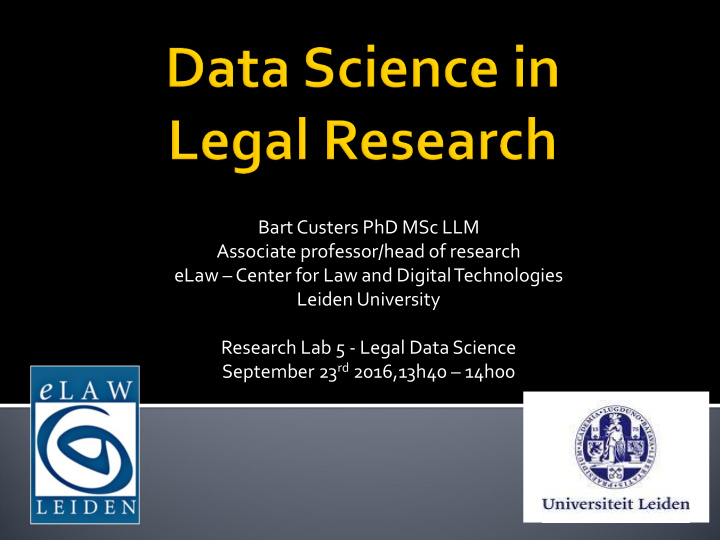



Bart Custers PhD MSc LLM Associate professor/head of research eLaw – Center for Law and Digital Technologies Leiden University Research Lab 5 - Legal Data Science September 23 rd 2016,13h40 – 14h00
Big Data • Volume (big) • Velocity (fast) • Variety (unstructured) https://www.youtube.com/watch?v=m Topic of this presentation: he5kX10CR4 (2’05’’) Data science as a new research method… … in the legal domain How can legal research benefit from data sciences? This presentation is NOT about regulating data sciences or big data. 2
Disrupting law school… In the USA, it is less desirable to be a lawyer today. Law school applications are down 40 % since 2005. Employment rates for law graduates are shrinking Advantages in technology and business model innovations are changing the traditional legal model: Legal solutions are more standardized and systematized Lawyers become more productive due to technological innovations Technological innovations offer solutions for non-lawyers 3
New perspectives Legal documents (legislation, case law, policy documents, research papers, etc.) are data: increasingly available in electronic formats new data analyses technologies (viz. big data analytics), such as data mining and text mining increased accessibility of files that were previously only available on paper New research methods in the legal domain that are more data-driven. Focus on statistical relations rather than causal relations Less focus on hypotheses and theory Increased efficiency and effectiveness Novel, unexpected results 4
Data science may contribute to answer different types of legal research questions What is How to Sociology Developing Developing existing interpret of law legal theory improved positive existing legislation law positive law Quantitative X X X X legal predictions Accelerate X X X X X research Improved X X X regulation 5
Ruger et al. (2004): tournament to predict US supreme court rulings Individual justices: ▪ Human experts: 68 % ▪ Model: 67 % Case outcome ▪ Human experts: 59 % ▪ Model: 75 % Katz et al. (2014) Model independent of ▪ Justice transition ▪ Ideological shift of justices ▪ Macro political/economic conditions Data for the Katz-model: • Over 60 years • 7,700 cases • 68,000 justice votes 6
Ravellaw https://www.ravellaw.com/se arch/m?query=privacy ROSS https://www.youtube.com/w atch?v=sbwEO8-Vox0 (1’05’’) Advantages • Decreasing the likelihood of missing important information • Increasing accuracy and reliability of research • Potential of novel, unexpected results 7
Not only legal documents are relevant data: example of social media COOSTO: http://open.coosto.com/nl/ Sentiment analyses: • public support? • timing? 8
Nudging: Use social media data for improved enforcement Increase knowledge about how people will behaviorally respond to proposed legislation This may help to create legislation that can be enforced more easily… … by nudging people into the expected behavior 9
Data science does not replace or invalidate other research methods Data science may be complementary to other methods: It may disclose novel, unexpected results It may improve efficiency/effectiveness of research Data science, however, provides limited opportunities for: Investigating causality Deeper understanding Theory development 10
? ? ? ? ? ? ? ? ? Thank you for your attention! Or contact me later: b.h.m.custers@law.leidenuniv.nl 11
Recommend
More recommend